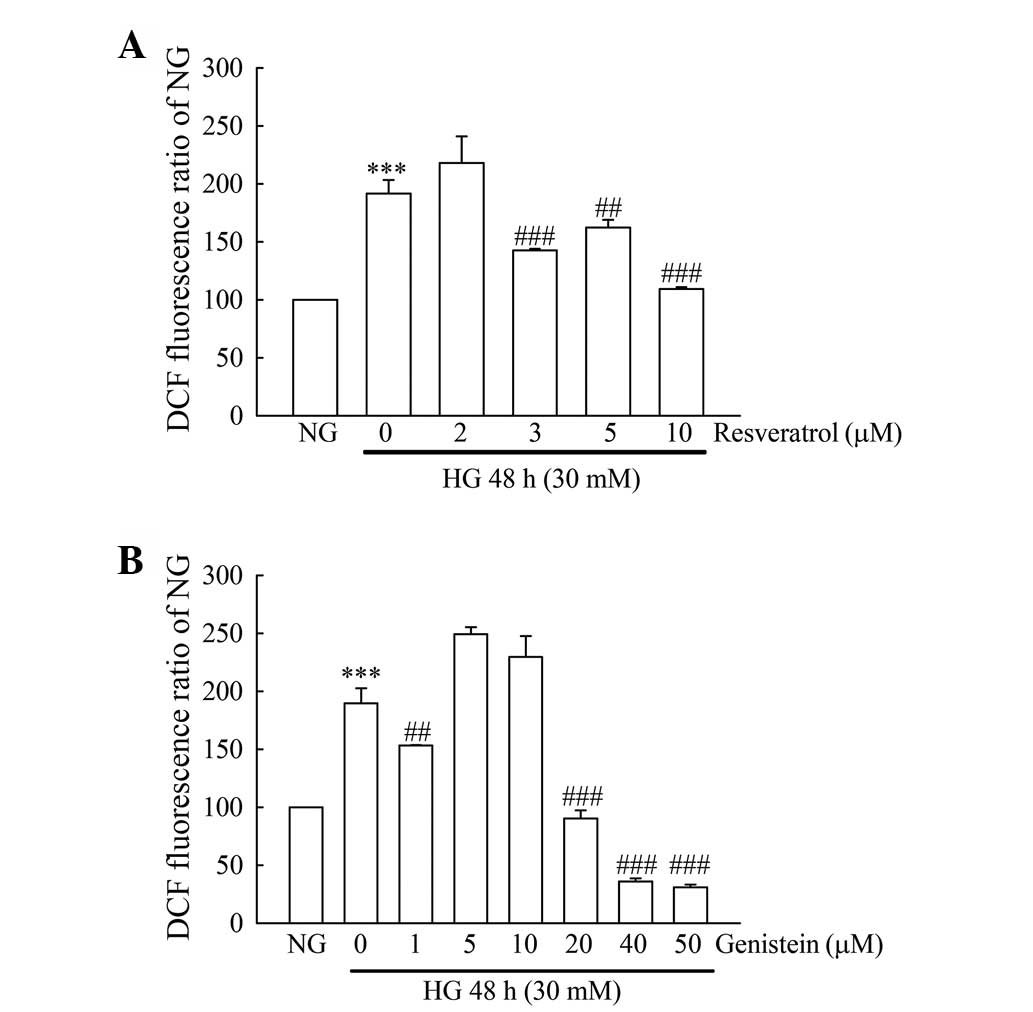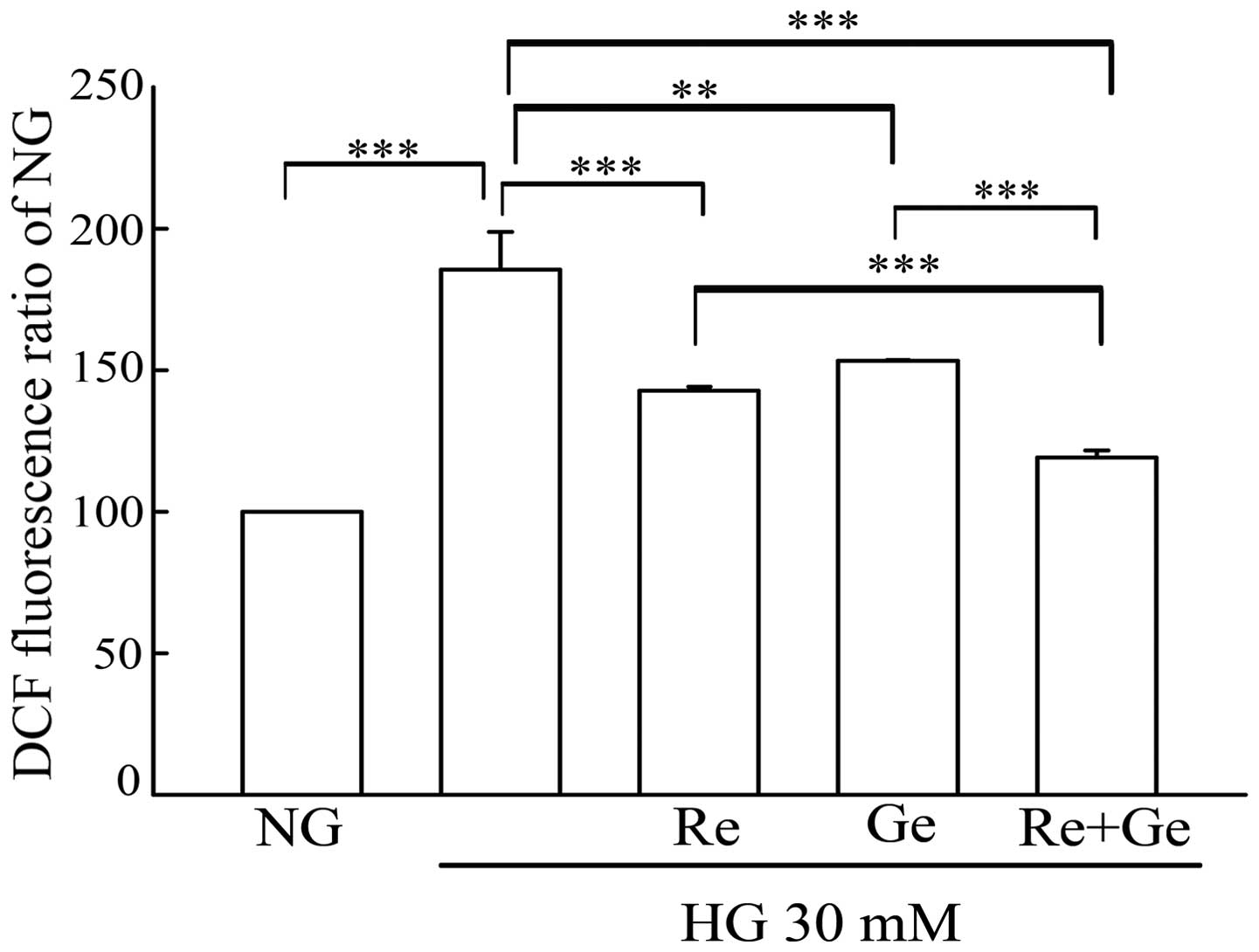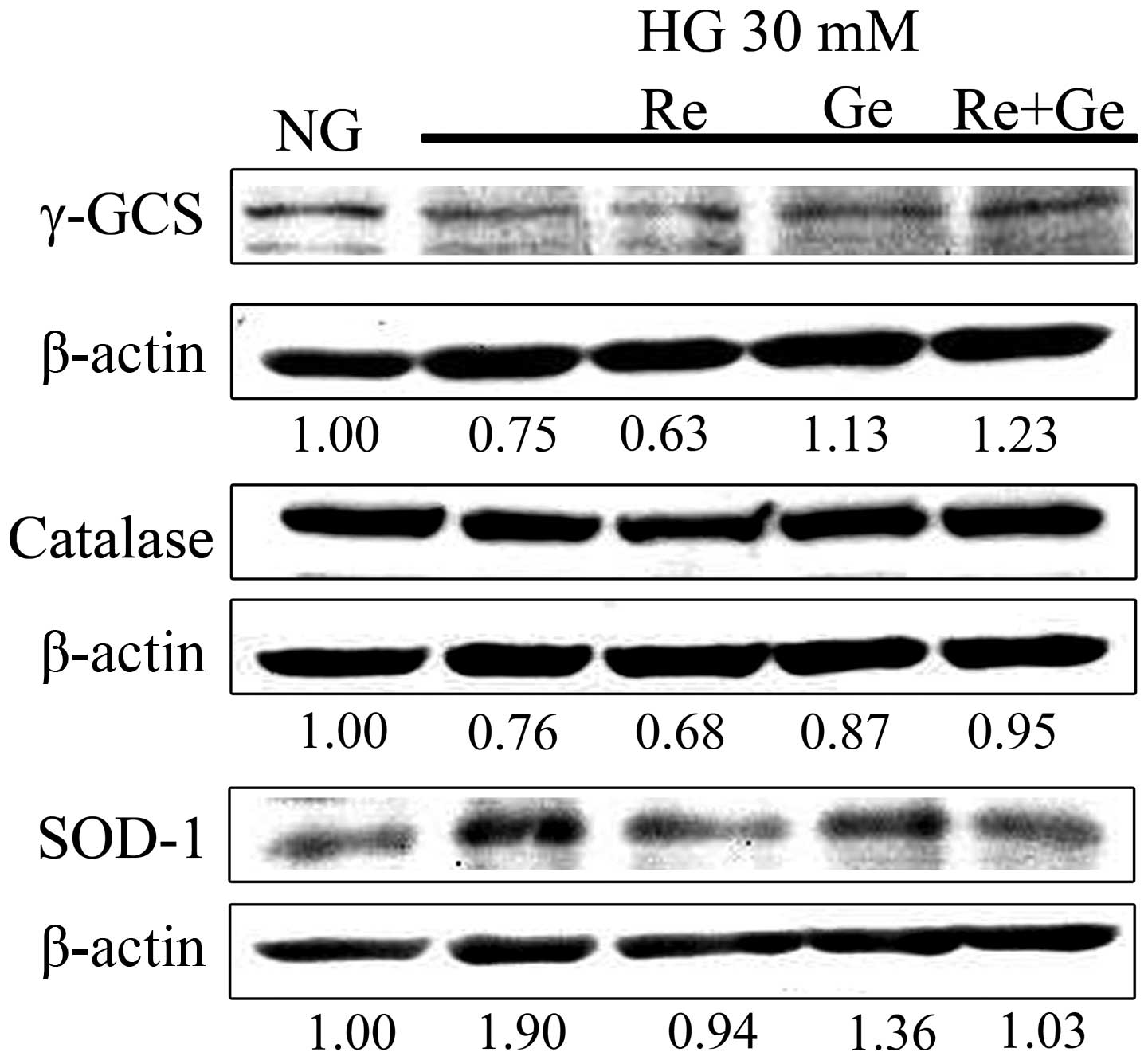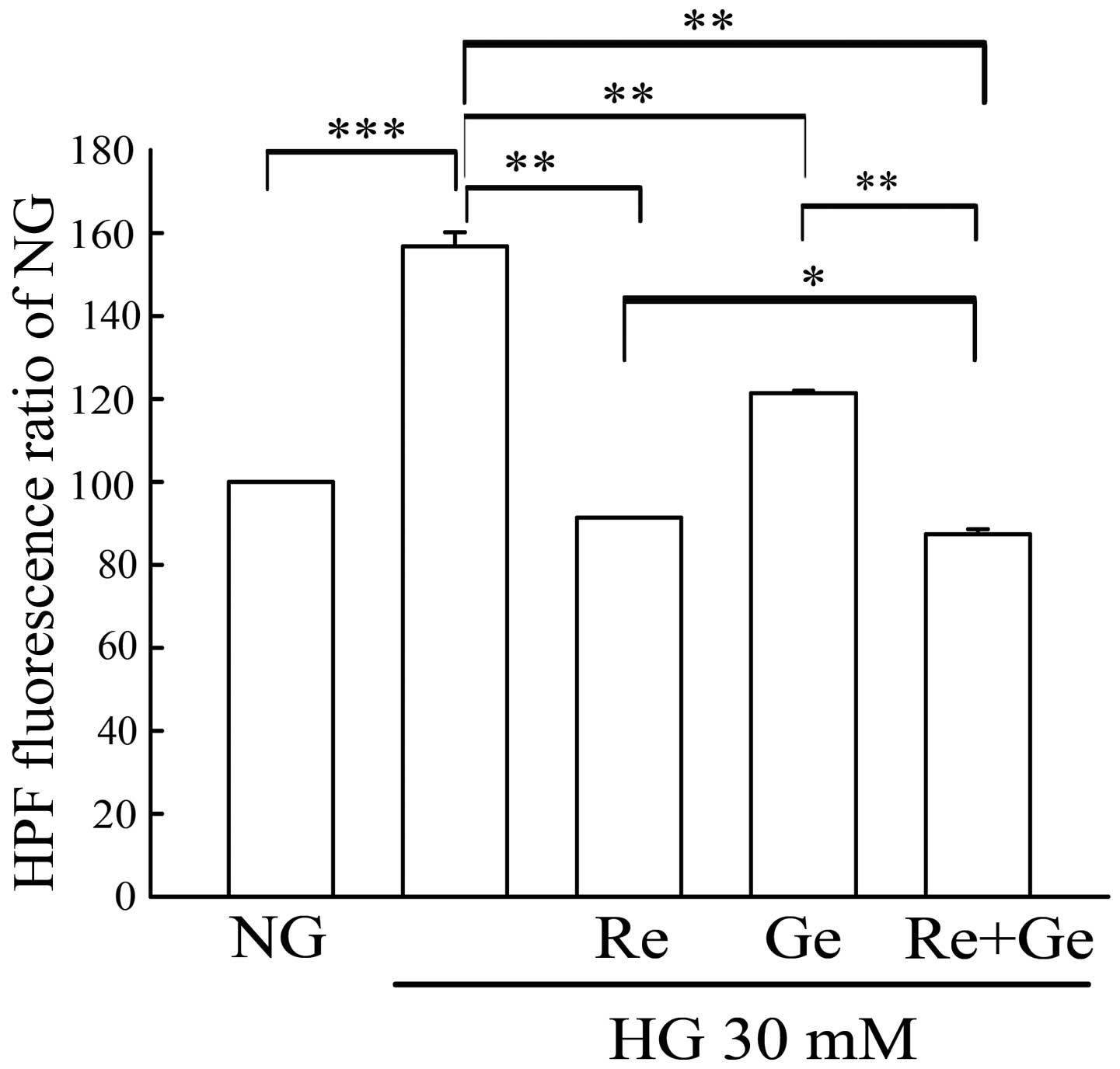Synergistic antioxidant activity of resveratrol with genistein in high-glucose treated Madin-Darby canine kidney epithelial cells
- Authors:
- Published online on: January 19, 2016 https://doi.org/10.3892/br.2016.573
- Pages: 349-354
Abstract
Introduction
Diabetes mellitus is a metabolic disease in which blood sugar concentrations are high over a prolonged period. Without proper treatment, diabetes mellitus can trigger a number of complications, including chronic kidney failure (1). Diabetic nephropathy is a critical event in end-stage renal failure worldwide. Its morphological features include glomerular hypertrophy, mesangial expansion, basement membrane thickening, interstitial fibrosis, tubular atrophy and arteriolar thickening (2). Numerous studies indicate that oxidative stress is a typical factor associated with the main pathways involved in the development and progression of diabetic microvascular and macrovascular complications of diabetes. There are a number of pathways that have been associated with increased production of intracellular reactive oxygen species (ROS), such as nicotinamide adenine dinucleotide phosphate (NADPH) oxidase, mitochondrial respiratory chain via oxidative phosphorylation, advanced glycation end products, defects in the polyol pathway and uncoupled nitric oxide synthase (2). Excess amounts of ROS directly damage cellular micromolecules and macromolecules, which eventually cause end-stage renal disease. Diminishing the production of ROS may be a favorable therapeutic treatment to improve renal damage from diabetic nephropathy.
Resveratrol (Re) is found in various plants, including grapes, berries and peanuts. It is also present in wine, particularly red wine. Re has been the focus of numerous studies investigating its biological attributes, which include mainly antioxidant activities (3). Re is believed to have antioxidant properties, protecting the body against the type of damage associated with an increased risk for conditions, such as cancer and heart disease. As Re is believed to have numerous health benefits, a number of manufacturers have tried to capitalize by the production of Re supplements.
Isoflavones are able to neutralize free radicals. Among the isoflavones, genistein (Ge) has the highest antioxidant activity. Ge may act as direct antioxidant, similar to a number of other isoflavones, and thus may alleviate the damaging effects of free radicals in tissues (4,5). Ge is a strong antioxidant that eliminates damaging free radicals and reduces lipid peroxidation, and increases the activity of other antioxidant enzymes, such as glutathione peroxidase, superoxide dismutase and glutathione reductase (6).
These previous studies emphasize the importance of Re and Ge in antioxidant activity and cellular protection from ROS damage. However, to the best of our knowledge, there are no previous studies evaluating the synergistic effects of Re with Ge on the high-glucose (HG) treatment in kidney cells and its possible protective mechanisms. The present study established a HG treatment in an MDCK cell line and evaluated the possible synergistic antioxidant efficacy of Re/Ge combination treatment. Specifically, the sources of ROS generation from the HG incubation of MDCK cells were examined and the molecular mechanisms underlying synergistic antioxidant activity were determined.
Materials and methods
Cell line and reagents
The MDCK cell line was obtained from the Bioresource Collection and Research Center (Hsinchu, Taiwan). Dichlorofluorescein diacetate (DCFH-DA) was acquired from Invitrogen Co. (Carlsbad, CA, USA). The primary antibodies against p47phox, p22, γ-glutamylcysteine synthetase (γ-GCS), catalase, superoxide dismutase-1 (SOD-1), glyceraldehyde 3-phosphate dehydrogenase (GAPDH) and secondary antibodies were obtained from Santa Cruz Biotechnology, Inc. (Santa Cruz, CA, USA). The primary antibodies against β-actin, hydroxyphenyl fluorescein (HPF) and other chemicals were purchased from Sigma-Aldrich (St. Louis, MO, USA).
Cell culture and treatment
MDCK (1×106) cells were cultured in a minimum essential medium (MEM) (90%) supplemented with 2 mM L-glutamine and Earle's BBS adjusted to contain 1.5 g/l sodium bicarbonate, 0.1 mM non-essential amino acids, 1.0 mM sodium pyruvate, 10% fetal bovine serum, 100 U/ml penicillin and 100 µg/ml streptomycin in 100-mm cultured dishes at 37°C in a humidified atmosphere of 5% CO2. When cells reached 80% confluence in the 100-mm cultured dishes, they were washed with phosphate-buffered saline (PBS) and trypsinized for use in various experiments. The MDCK cells were plated in 60- or 100-mm culture dishes for 24 h. The culture medium was replaced with five types of media: i) Normal glucose MEM medium (NG) containing 5.5 mM glucose, ii) HG MEM medium (HG) containing 30 mM glucose, iii) 3 µM Re alone in HG medium, iv) 1 µM Ge alone in HG medium and v) Re and Ge in HG medium for 48 h. The selective inhibitors and the particular concentrations used to inhibit the intracellular ROS generation from various enzymes were referenced and modified from our previous study (7). The particular concentrations of the selective inhibitors did not affect the cell viability of MDCK cells. The selective inhibitor of mitochondrial complex I [20 nM rotenone (RO)], mitochondrial complex II [5 µM carboxin (Car) or 5 µM 2-ethenoyltrifluoroacetone (TTFA)], mitochondrial complex III [0.1 nM antimycin A (AA)], NADPH oxidase [2 µM 4-(2-aminoethyl)benzenesulfonyl fluoride hydrochloride (AEB) or 30 µM apocynin (Apo)], xanthine oxidase [10 µM allopurinol (Allo)] and liopoxygenase [5 µM nordydihydroguaiaretic acid (Nordy)] were pretreated for 1 h, followed by HG treatment for 48 h. These inhibitors were purchased from Sigma-Aldrich.
Measurement of intracellular ROS by flow cytometry
Production of intracellular ROS was detected by flow cytometry using the DCFH-DA probe (Sigma-Aldrich). The MDCK (2×105) cells were plated in 60-mm culture dishes for 24 h. The culture medium was replaced with five types of media, as aforementioned. Cells were treated with 10 µM DCFH-DA for 30 min in the dark, washed once with PBS, collected by centrifugation (200 × g) for 5 min at room temperature, and were subsequently suspended in PBS. Intracellular ROS levels indicated by the fluorescence of dichlorofluorescein (DCF) were evaluated by excitation at 488 nm and measured through a 530/22-nm barrier filter using a Becton-Dickinson FACScan flow cytometer (BD Biosciences, San Diego, CA, USA) (7). The data were acquired, analyzed and plotted by the CellQuest Pro software (BD Biosciences) and the SigmaPlot 10.0 software (Systate Software, Inc., San Jose, CA, USA).
Western blot analysis
The MDCK (4×105) cells were plated in 100-mm culture dishes for 24 h. The culture medium was replaced with five types of media, as aforementioned. Following treatment, the cells were washed with PBS, resuspended in a protein extraction buffer for 10 min, and centrifuged at 12,000 × g for 10 min at 4°C to obtain the total extracted proteins (in the supernatant). Protein concentrations were measured with a Bio-Rad protein assay reagent (Bio-Rad, Richmond, CA, USA). The extracted cellular proteins were boiled in loading buffer, and an aliquot corresponding to 60–100 µg of protein was separated on a 12% sodium dodecyl sulfate (SDS)-polyacrylamide gel. Following electrophoresis, proteins were electrotransferred onto a polyvinylidene fluoride transfer membrane. Following blotting, the membranes were incubated with various primary antibodies overnight [p47phox polyclonal antibody (rabbit anti-human; 1:1,000 dilution; cat. no. sc-14015; Santa Cruz Biotechnology, Inc.), p22 polyclonal antibody (rabbit anti-human; 1:500 dilution; cat. no. sc-20781; Santa Cruz Biotechnology, Inc.), γ-GCS polyclonal antibody (rabbit anti-human; 1:750 dilution; cat. no. sc-22755; Santa Cruz Biotechnology, Inc.), SOD-1 monoclonal antibody (mouse anti-human; 1:750 dilution; cat. no. sc-17767; Santa Cruz Biotechnology, Inc.), GAPDH polyclonal antibody (rabbit anti-human; 1:5,000 dilution; cat. no. sc-25778; Santa Cruz Biotechnology, Inc.), catalase polyclonal antibody (rabbit anti-human; 1:5,000 dilution; cat. no. 219010; Merck Millipore Corporation) or β-actin polyclonal antibody (rabbit anti-human; 1:1,000 dilution; cat. no. A5060; Sigma-Aldrich Co.)] and were washed with PBST solution 0.05% Tween-20 in PBS (PBST). Subsequent to washing, the secondary antibodies (goat anti-rabbit; 1:10,000 dilution; cat. no. sc-2004; or goat anti-mouse; 1:5,000 dilution; cat. no. sc-2005; Santa Cruz Biotechnology, Inc.) labeled with horseradish-peroxidase was added to the membrane for 1 h and the sample was washed with PBST solution. The antigen-antibody complexes were detected by enhanced chemiluminescence (Amersham Pharmacia Biotech, Piscataway, NJ, USA) with a chemiluminescence analyzer.
Statistical analysis
Data are presented as the mean ± standard deviation of at least 3 independent experiments and were analyzed using Student's t-test by the Sigma Plot 10.0 software. P<0.05 was considered to indicate a statistically significant difference.
Results
Antioxidant activity of Re and Ge in HG treatment
The antioxidant activity of Re and Ge in HG treatment was first evaluated in MDCK cells by DCFH-DA staining and flow cytometry. The DCFH-DA is a probe for intracellular ROS. In Fig. 1, 30 mM glucose (HG) incubation induced a 1.7-fold intracellular ROS increase, as compared with 5.5 mM glucose (NG) treatment. Re (3, 5 and 10 µM) treatment led to a significant inhibition of intracellular ROS as compared with the HG treatment. The significant inhibition of intracellular ROS appeared following 1, 20, 40 and 50 µM Ge treatment, but not in 5 and 10 µM of Ge treatment. To evaluate the synergistic antioxidant activity in Re and Ge, 3 µM of Re and 1 µM of Ge were selected for the further experiments.
Re with Ge synergistically inhibits intracellular ROS in HG treatment
The antioxidant activity of Re alone, Ge alone and the Re/Ge combination in HG-treated MDCK cells was evaluated by DCFH-DA staining and flow cytometry. Glucose (HG) of 30 mM of treatment induced a 1.7-fold intracellular ROS as compared with 5.5 mM glucose (NG) treatment (Fig. 2). Re alone or Ge alone led to significant inhibition of intracellular ROS as compared with HG treatment. Of note, the intracellular ROS was significantly inhibited in the combined administration of Re and Ge, as compared with a single compound treatment.
Multiple sources of ROS are induced by HG treatment in MDCK cells
To evaluate the ROS sources of HG-treated MDCK cells, cells were pre-incubated with 20 nM RO (a complex I inhibitor), 5 µM TTFA (a complex II inhibitor), 5 µM Car (a complex II inhibitor), 0.1 nM AA (a complex III inhibitor), 2 µM AEB (a NADPH oxidase inhibitor), 30 µM Apo (an NADPH oxidase inhibitor), 10 µM Allo (a xanthine oxidase inhibitor) or 5 µM Nordy (a lipoxygenase inhibitor) for 1 h, followed by co-incubation with 30 mM glucose (HG) for 48 h. Following treatment, the intracellular ROS production was measured using the DCFH-DA probe. A significant increase in intracellular ROS following HG treatment was observed in the MDCK cells (Fig. 3). The HG-induced intracellular ROS produced, measured using the DCFH-DA probe and flow cytometry, was significantly scavenged when cells were pre-incubated for 1 h with RO, AEB, Apo, Allo and Nordy in the MDCK cells (Fig. 3). However, TTFA, Car and AA did not scavenge the HG-induced intracellular ROS. These results indicated that there were 4 main sources of ROS, including mitochondrial complex I, NADPH oxidase, xanthine oxidase and lipoxygenase, induced by HG incubation in MDCK cells.
Re/Ge synergistically inhibits NADPH oxidase expression in HG treatment
NADPH oxidase is a main source of intracellular ROS production. The intracellular ROS produced by HG treatment also involved NADPH oxidase. The expression of two subunits of NADPH oxidase, p47phox and p22, were further evaluated in HG incubation. In Fig. 4, the expression of p22 was increased to 1.78-fold in HG-treated cells. Of note, Re or Ge alone treatment led to a 2.25- and 2.89-fold increase of p22 expression. There was no increased expression following treatment with the Re/Ge combination in the HG-treated cells (only 0.99-fold p22). Treatment with Re or Ge alone decreased the p47phox expression to 0.54- and 0.59-fold of the NG treatment. The Re/Ge combination caused more inhibition of p47phox expression, which was 0.28-fold of the NG incubation.
Re with Ge synergistically effects the expression of antioxidant enzymes in HG treatment
γ-GCS, catalase and SOD-1 are three critical antioxidant enzymes, which act against cellular ROS during oxidative stress. To evaluate the expression of these antioxidant enzymes in HG incubation, western blotting was used. The expression of γ-GCS decreased to 0.75-fold in the HG treatment as compared with NG incubation (Fig. 5). The expression level of γ-GCS following treatment with Re alone in HG incubation was decreased to 0.63-fold. However, an increase to 1.13-fold was observed in the expression of γ-GCS when MDCK cells were treated with Ge alone in HG for 48 h. Treatment with the Re/Ge combination in HG-treated cells for 48 h further increased the γ-GCS expression to 1.23-fold as compared with NG incubation. The data appear to indicate that the increased expression of γ-GCS for the Re/Ge combination treatment in HG-treated cells is an important event for ROS elimination. The catalase expression was markedly decreased to 0.76- and 0.68-fold in HG incubation and Re alone treatment, respectively. Notably, catalase expression was 0.95-fold in the Re/Ge combination treatment in the HG incubation. The expression of SOD-1 in MDCK cells was increased to 1.9-fold in the HG treatment at 48 h; however, the Re/Ge combination in the HG incubation resulted in 1.03-fold of SOD-1 expression as compared with NG incubation.
Re/Ge synergistically inhibits intracellular hydroxyl radials in HG treatment
The antioxidant activity on hydroxyl radicals of Re alone, Ge alone and Re/Ge combination in the HG-treated MDCK cells was evaluated by HPF staining and flow cytometry. HG incubation induced a 1.5-fold increase in intracellular hydroxyl radicals as compared with NG incubation (Fig. 6). Re alone or Ge alone led to a significant inhibition of intracellular hydroxyl radicals as compared with HG incubation. Of note, the intracellular hydroxyl radicals were significantly inhibited in the Re/Ge combination as compared with Re or Ge alone treatment.
Discussion
In Fig. 3, RO (a complex I inhibitor) inhibited the largest amount of ROS in the HG treatment, suggesting the site of the ROS source provided from HG incubation is mitochondrial complex I. Previous studies have indicated that the hyperglycemia characteristics of diabetes increase the complex I substrate NADH (8), which is likely to potentiate ROS production by the respiratory chain (9). This is in agreement with the present finding that mitochondrial complex I generated the maximum amount of ROS in the HG-treated MDCK cells. An important source of ROS production is NADPH oxidase. This enzyme results in superoxides during the respiratory burst in phagocytes. The NADPH oxidase consists of membrane-bound subunits (gp91phox and p22phox) and cytosolic subunits (p47phox, p40phox, p67phox and Rac) (10). When activated, p47phox is phosphorylated, and the cytosolic components translocate to the membrane, where they form a molecular cluster of the catalytically active oxidase. The expression of p47phox appeared to exhibit the largest inhibition by the Re/Ge combination as compared with Re or Ge alone, indicating that the Ge/Re combination inhibits the activation of NADPH oxidase in HG incubation.
Xanthine oxidase is an enzyme that converts hypoxanthine/xanthine to uric acid in a reaction that liberates superoxide. High activity of xanthine oxidase has been observed in numerous pathological conditions, as the xanthine oxidase-generated superoxide is cytotoxic. A significant increase in the activity of xanthine oxidase was observed in diabetics (11). Inhibition of xanthine oxidase reduces hyperglycemia-induced oxidase stress in skeletal muscle of diabetic mice. Evidence is accumulating that some of the products derived from the actions of lipoxygenases contribute to diabetic nephropathy. Specifically, levels of lipoxygenases 12 and 15 are increased in diabetic animals. In addition, HG levels increase the expression of lipoxygenases 12 and 15 in cultured mesangial cells (12). The results of the present study show that Allo (a xanthine oxidase inhibitor) and Nordy (a lipooxygenase inhibitor) inhibited a partial ROS level in HG-incubated MDCK cells (Fig. 3) suggesting that xanthine oxidase and lipoxygenase also have important roles in ROS generation of kidney cells in diabetes.
Other possible mechanisms by which HG incubation increases intracellular ROS is the upregulation of SOD-1 observed in MDCK cells (Fig. 5). SOD-1 is a superoxide metabolic enzyme that metabolizes superoxide to H2O2, which is further metabolized to H2O and O2 by catalase. HG incubation markedly increased the expression of SOD-1, and this effect would result in intracellular superoxide being converted to H2O2 (Fig. 5). Furthermore, as HG incubation significantly inhibited the expression of catalase to 0.76-fold (Fig. 5), the elimination of intracellular H2O2 may not be executed normally in MDCK cells and may ultimately contribute to the increase in intracellular H2O2 after 48 h of HG incubation. By contrast, the Re/Ge combination could recover the expression of catalase to 0.95-fold in HG incubation suggesting that the synergistic antioxidant activity is partially a result from the maintenance of catalase expression.
γ-GCS is the first enzyme of the cellular glutathione (GSH) biosynthetic pathway that catalyzes the chemical reaction. GSH combines with hydroxyl radical, peroxynitrite, and hydroperoxides, as well as reactive electrophiles, including activated phosphoramide mustard (13). The activity of γ-GCS was significantly lower in diabetics compared to normal controls (14). A decreased expression of γ-GCS in diabetic rats is consistent with repressed GSH synthesis (15). These results are in agreement with the present findings that the expression of γ-GCS in HG incubation was decreased to 0.75-fold of NG-incubated cells. The expression of γ-GCS was increased to 1.23-fold in the Re/Ge combination indicating another important antioxidant mechanism of the Re/Ge combination, which provides an enhanced GSH synthesis function to antagonize the ROS in HG incubation.
Re has potent protective effects on diabetes and diabetic complications including diabetic nephropathy. Xu et al (16) demonstrated that pretreatment with Re (10 µM) for 6 h prior to HG (30 mM) treatment for 48 h significantly reduced the hyperglycemia-induced increase in ROS production in rat mesangial cells. This is in agreement with the present results, as Re (10 µM) alone decreased HG-induced ROS in MDCK cells. In addition, another study also demonstrated that the addition of Ge to soy protein causes improvements in the antioxidant status of kidney tissue. The catalase activity was significantly increased in soy/Ge treatment (17). The present findings explain the observation that the low concentration of Re (3 µM) in combination with Ge (1 µM) could further decrease the HG-induced ROS, suggesting that an important synergistic antioxidant effect may be applied in diabetic nephropathy.
Acknowledgements
The present study was supported by a grant from the Ministry of Economic Affairs of Taiwan, R.O.C (no. 104-EC-17-A-18-S1-226).
References
|
Tisminetzky M, McManus DD, Dor A, Miozzo R, Yarzebski J, Gore JM and Goldberg RJ: Decade-long trends (1999-2009) in the characteristics, management, and hospital outcomes of patients hospitalized with acute myocardial infarction with prior diabetes and chronic kidney disease. Int J Nephrol Renovasc Dis. 8:41–51. 2015.PubMed/NCBI | |
|
Kashihara N, Haruna Y, Kondeti VK and Kanwar YS: Oxidative stress in diabetic nephropathy. Curr Med Chem. 17:4256–4269. 2010. View Article : Google Scholar : PubMed/NCBI | |
|
de la Lastra CA and Villegas I: Resveratrol as an antioxidant and pro-oxidant agent: mechanisms and clinical implications. Biochem Soc Trans. 35:1156–1160. 2007. View Article : Google Scholar : PubMed/NCBI | |
|
Han RM, Tian YX, Liu Y, Chen CH, Ai XC, Zhang JP and Skibsted LH: Comparison of flavonoids and isoflavonoids as antioxidants. J Agric Food Chem. 57:3780–3785. 2009. View Article : Google Scholar : PubMed/NCBI | |
|
Borrás C, Gambini J, López-Grueso R, Pallardó FV and Viña J: Direct antioxidant and protective effect of estradiol on isolated mitochondria. Biochim Biophys Acta. 1802:205–211. 2010. View Article : Google Scholar : PubMed/NCBI | |
|
Ullmann K, Wiencierz AM, Müller C, Thierbach R, Steege A, Toyokuni S and Steinberg P: A high-throughput reporter gene assay to prove the ability of natural compounds to modulate glutathione peroxidase, superoxide dismutase and catalase gene promoters in V79 cells. Free Radic Res. 42:746–753. 2008. View Article : Google Scholar : PubMed/NCBI | |
|
Yang JT, Li ZL, Wu JY, Lu FJ and Chen CH: An oxidative stress mechanism of shikonin in human glioma cells. PLoS One. 9:e941802014. View Article : Google Scholar : PubMed/NCBI | |
|
Kabat A, Pönicke K, Salameh A, Mohr FW and Dhein S: Effect of a beta 2-adrenoceptor stimulation on hyperglycemia-induced endothelial dysfunction. J Pharmacol Exp Ther. 308:564–573. 2004. View Article : Google Scholar : PubMed/NCBI | |
|
Brownlee M: Biochemistry and molecular cell biology of diabetic complications. Nature. 414:813–820. 2001. View Article : Google Scholar : PubMed/NCBI | |
|
Babior BM: NADPH oxidase. Curr Opin Immunol. 16:42–47. 2004. View Article : Google Scholar : PubMed/NCBI | |
|
Suriyajothi MA, Sangeetha R and Venkateswari R: Activity of xanthine oxidase of diabetes: Its correlation with aging. Pharmacologyonline. 2:128–133. 2011. | |
|
Hao CM and Breyer MD: Roles of lipid mediators in kidney injury. Semin Nephrol. 27:338–351. 2007. View Article : Google Scholar : PubMed/NCBI | |
|
Griffith OW and Mulcahy RT: The enzymes of glutathione synthesis: Gamma-glutamylcysteine synthetase. Adv Enzymol Relat Areas Mol Biol. 73:209–267, xii. 1999.PubMed/NCBI | |
|
Murakami K: Glutathione metabolism in erythrocytes from patients with diabetes mellitus. Hokkaido Igaku Zasshi. 66:29–40. 1991.(In Japanese). PubMed/NCBI | |
|
Furfaro AL, Nitti M, Marengo B, Domenicotti C, Cottalasso D, Marinari UM, Pronzato MA and Traverso N: Impaired synthesis contributes to diabetes-induced decrease in liver glutathione. Int J Mol Med. 29:899–905. 2012.PubMed/NCBI | |
|
Xu Y, Nie L, Yin YG, Tang JL, Zhou JY, Li DD and Zhou SW: Resveratrol protects against hyperglycemia-induced oxidative damage to mitochondria by activating SIRT1 in rat mesangial cells. Toxicol Appl Pharmacol. 259:395–401. 2012. View Article : Google Scholar : PubMed/NCBI | |
|
Javanbakht MH, Sadria R, Djalali M, Derakhshanian H, Hosseinzadeh P, Zarei M, Azizi G, Sedaghat R and Mirshafiey A: Soy protein and genistein improves renal antioxidant status in experimental nephrotic syndrome. Nefrologia. 34:483–490. 2014.PubMed/NCBI |















